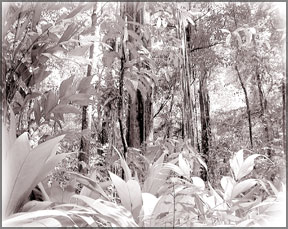Earth has a voice
Can Man-Made Noise Be Altering Earth’s Ecology?
by Clive Thompson
Bernie Krause listens to nature for a living. The 69-year-old is a
field recording scientist: He heads into the wilderness to document the
noises made by native fauna - crickets chirping in the Amazon rain
forest, frogs croaking in the Australian outback.
But Krause has noticed something alarming. The natural sound of the
world is vanishing. He’ll be deep inside the Amazon, recording that
cricket, but when he listens carefully he also hears machinery: The
distant howl of a 747 or the dull roar of a Hummer miles way.
|

Amazon rain forest |
Krause has a word for the pristine acoustics of nature: biophony.
It’s what the world sounds like in the absence of humans. But in 40
percent of the locations where Krause has recorded over the past 40
years, human-generated noise has infiltrated the wilderness. “It’s
getting harder and harder to find places that aren’t contaminated,” he
says.
This isn’t just a matter of aesthetics. The contamination of biophony
may soon become a serious environmental issue - Krause says that
man-made sounds are already wreaking havoc with animal communication.
We worry about the carbon emissions from SUVs and airplanes; maybe we
should be equally concerned about the racket they cause.
Krause’s argument is simple. In a biophony, animals divide up the
acoustic spectrum so they don’t interfere with one another’s voices.
He shows me a spectrogram of a wilderness recording, in which all the
component noises are mapped according to pitch. It looks like the
musical score for an orchestra, with each instrument in its place. No
two species are using the same frequency.
“That’s part of how they coexist so well,” Krause says. When they
issue mating calls or all-important warning cries, they aren’t masked by
the noises of other animals.
But what happens when man-made noise - anthrophony, as Krause dubs it
- intrudes on the natural symphony? Maybe it’s the low rumble of nearby
construction or the high whine of a turboprop. Either way, it interferes
with a segment of the spectrum already in use, and suddenly some animal
can’t make itself heard. The information flow in the jungle is
compromised.
Krause has heard this happen all over the world. For example, the
population of spadefoot toads in the Yosemite region of the Sierras is
declining rapidly, and Krause thinks it’s because of low-flying military
training missions in the area.
The toad calls lose their synchronicity, and coyotes and owls home in
on individual frogs trying to rejoin the chorus. And as Krause has
discovered, it doesn’t take much to disrupt a soundscape.
California’s Lincoln Meadow, for example, has undergone only a tiny
bit of logging, but the acoustic imprint of the region has completely
changed in tandem with the landscape, and some species seem to have been
displaced.
The area looks the same as ever, “but if you listen to it, the
density and diversity of sound is diminished,” Krause says. “It has a
weird feeling.”
Biologists were initially skeptical of Krause’s theory, but he’s
slowly gaining converts. Now even bigwigs like Harvard’s E. O. Wilson
have gone on record in support.
So how do you quiet an increasingly cacophonous world? Perhaps we
should be developing not just clean tech but “quiet” tech, industrial
machinery designed to run as silently as possible. More regulations
could help, too. Cities have long had noise ordinances; wilderness areas
could benefit from tighter protections as well.
Some of this is just about educating ourselves. We all recognize
ecological tragedies by sight - when we see pictures of clear-cut areas,
say, or melting Arctic ice shelves. Now we need to learn to listen to
the earth, too.
Last year, Krause brought biophony to the masses by creating an
extraordinarily cool add-on for Google Earth. Download it from his
WildSanctuary.com site and you can click on dozens of locations
worldwide to hear snippets of their soundscape.
I select the Amazon rain forest and my office is suddenly filled with
a mesmerizing mix of hoots, cries, and rustling. It’s spooky - like
nothing I’ve ever heard before.
And like nothing I’ll ever hear again, if we don’t watch out. “Earth
has a voice,” Krause says. “We can’t let it go silent.” |
